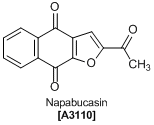Maintenance Notice (3:15 AM - 2:55 PM May 24, 2025 UTC): This website is scheduled to be unavailable due to maintenance. We appreciate your patience and understanding.
Product Document Searching Made Easy by 2D Code! | TCI Materials Science News May 2025 | [Product Highlights] Endogenous Biotin-Blocking Reagent... | Various analytical charts can be searched on each product detail page and Product Document Search (The kinds of analytical charts differ by product)
Maximum quantity allowed is 999
Please select the quantity
Antitumor Phytochemical Inhibiting Cancer Stem Cells
The biologically active furanonaphthoquinone napabucasin was found originally in the stem bark of Tabebuia cassinoides.1) It has been reported that napabucasin exhibits the impressive cytotoxicity against KB cells as well as various cancer cell lines.1-4) Furthermore, napabucasin can kill cancer stem cells isolated from many types of cancer tissue through inhibition STAT3 (signal transducer and activator of transcription 3)-driven gene transcription. Since napabucasin effectively suppresses cancer relapse and metastasis in mice, napabucasin is expected to contribute to the development of cancer therapeutics.5)

Related Products
References
- 1)Plant anticancer agents. XII. Isolation and structure elucidation of new cytotoxic quinones from Tabebuia cassinoides
- 2)Furanonaphthoquinone Analogs Possessing Selectivity in Antitumor Activity Compared to Normal Cells
- 3)Cytotoxic activity toward KB cells of 2-substituted naphtho[2,3-b]furan-4,9-diones and their related compounds
- 4)Anticancer Activities of Six Selected Natural Compounds of Some Cameroonian Medicinal Plants
- 5)Suppression of cancer relapse and metastasis by inhibiting cancer stemness